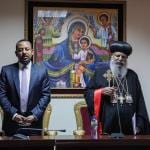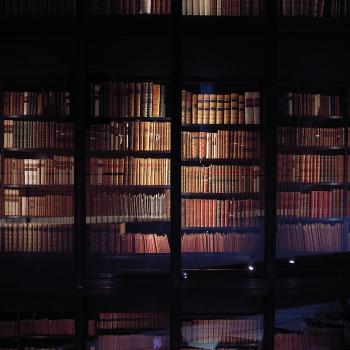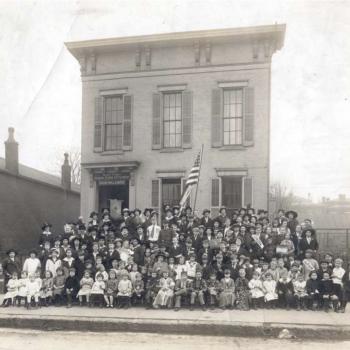Last week I got an unusual opportunity to live out the tagline of The Anxious Bench: “The Relevance of Religious History for Today.” A colleague asked me to guest lead a discussion in his education department graduate course “Foundations and History of Higher Education.” I have lots of experience using religious history to train graduate students—who plan to go on to be historians like me! It was fascinating to instead use religious history to train graduate students who plan to go on to be higher education professionals in either administration or student life.
This exercise got me thinking more about what wisdom we can glean from the past for how to approach higher education in the present—as administrators, teachers, parents, students, or donors.
Before the discussion, the students read an article I wrote a few years ago on how the moral formation of Princeton students changed in the decades around 1900. In brief, I argued that at Princeton during these years students experienced a much greater push to develop specifically masculine character traits (as opposed to simply Christian ones) and engage in specifically masculine forms of public service—even though the college had always admitted only men. I further argued that changing religious ideas played a key role in this shift, but that the way these changes shaped student experience on the ground was complex.
This shift in moral formation mattered in part because it reverberated beyond these students’ lives: graduates went on to have big effects on the world outside the university. Specifically, I argued that the fact “that students embraced these changes suggests that a new approach to moral formation at prominent men’s colleges—and coeducational universities that copied their approach—may help explain why, in an era when women could first access an education equal to men’s, educated men nevertheless continued to see themselves as uniquely suited for certain public leadership roles by virtue of their sex.”
So how exactly did the students of that era get that message and what can we learn from that process?
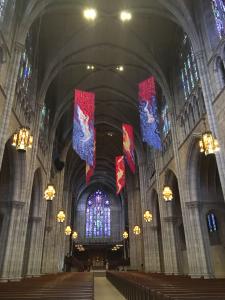
The Baylor students in the graduate course are training to be future college and university leaders, so I had them view my article as a case study. Our present culture is not the same, but our colleges and universities still have a similar structure to the one common a century ago. I therefore asked students to break into groups to discuss the different influences Princeton students encountered during their college years. Specifically, I asked them to look for what influenced undergraduates’ sense of identity and their ethical compass.
One group looked at the influence of administrators, all of whom were committed Protestants of some stripe. A second group considered the role of students’ extracurricular life, specifically as it involved voluntary religious and service organizations. The final group asked about the influence on students of wider cultural trends over which educational leaders had little control.
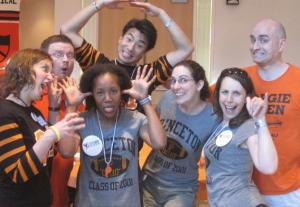
The Baylor graduate students uncovered a plethora of possible influences. Administrators at the time engaged in constant messaging as to the purpose of a university education. And these administrators’ religious convictions and ideals of masculinity shifted over time in mutually reinforcing ways. Administrators also had the power to pursue their vision by setting requirements for students—which courses they had to take, whether and how often they attended chapel (and what was said there), which student organizations were allowed on campus and which got favored administrative support. Finally, administrators set the admissions policy—they determined who got in, and hence who students’ peers were. These peers would in turn exercise additional influence over their fellow students.
But Princeton undergraduates also had some control over their own education. They could elect some of their own classes and lot of their own extracurricular activities. Yet sometimes here the lines of choice blurred. Princeton’s Protestant Philadelphian Society was the second most popular student organization—second only to Princeton’s two debating societies combined—and it was a branch of the national Young Men’s Christian Association (YMCA). Hence trends in the national organization—shifts in theology and gender ideals which paralleled those among Princeton’s administrators—affected trends on the ground at Princeton. Plus, as at most colleges at the time, administrators actually outsourced freshman orientation to the YMCA, which allowed the organization to recruit a far higher percentage of students than would have otherwise been possible.
Finally, students lived in a culture shaped by national trends over which leaders—be they university administrators or heads of student organizations—had little direct control. Students went to college expecting to participate in fraternities and athletics and these activities in turn shaped students’ sense of purpose. Intellectual trends within Protestant Christianity—the brewing fundamentalist-modernist controversy—shaped the mental world within which college administrators and student leaders alike staked their particular place on this spectrum. And the gender ideals of American culture at the time constituted the cultural waters in which students swam, whether with or against.
I asked discussion participants which of these three areas—administrators, student organizations, or wider culture—had more influence over undergraduates. Answers were almost equally divided. Participants also rightly listed other factors I didn’t cover as much in the article—especially individual faculty members and courses.
So what do we make of all this? As historians are fond of saying, “It’s complicated.” But I am confident from my research that the years students spend at college really do affect their sense of identity and their moral compass—not only a century ago but also today. (And the students in this class agreed when I wasn’t even grading them!) What happens at universities matters.
As I have written elsewhere, it also matters because universities have served as nodes of American culture: “wider cultural norms influenced their views, and their views in turn fed back to reshape such norms through how they trained the cultural leaders of the next generation.”
I therefore encouraged this class of future higher education professionals to study the history behind the profession they wanted to enter in order to learn to think outside the box of the present. Maybe the way we organize universities today is not the best possible way, but we can’t easily imagine alternatives without learning about previous ways it has been done. On the flip side, maybe there are good reasons for some of the things we do now and we want to make sure not to get rid of them in our efforts to reform what needs reforming.
My personal take away from the discussion was a sense of both humility and responsibility. As a professor, I cannot control what moral message students take away from their college experience as a whole. There are too many factors at play. But at the same time, I can control my own classroom and my relationships with students. And that really is a piece of the message they hear as they are forming their sense of self and ethical compass. I can also contribute to a lesser extent to the entire way students’ education is structured through committee service concerned with these larger questions. And at a university like Baylor I can think more explicitly about how faith factors in.
For those who are students, parents, or donors, I would encourage us to think about the entire college experience as a whole when we make decisions about where to attend college or what colleges to support, as well as how to navigate all the possibilities and pitfalls inevitably present wherever we choose.
More on religion and higher education next month!


